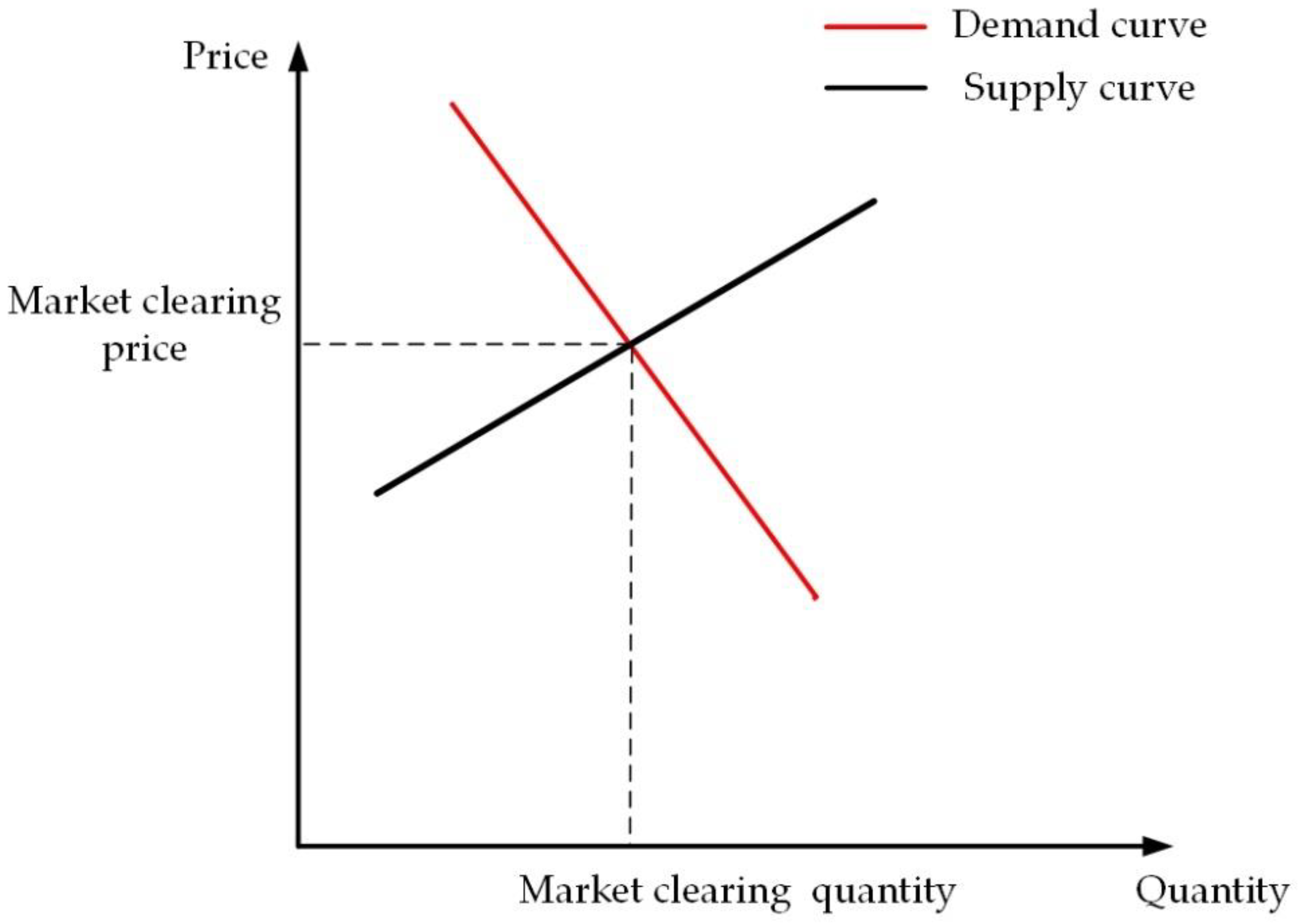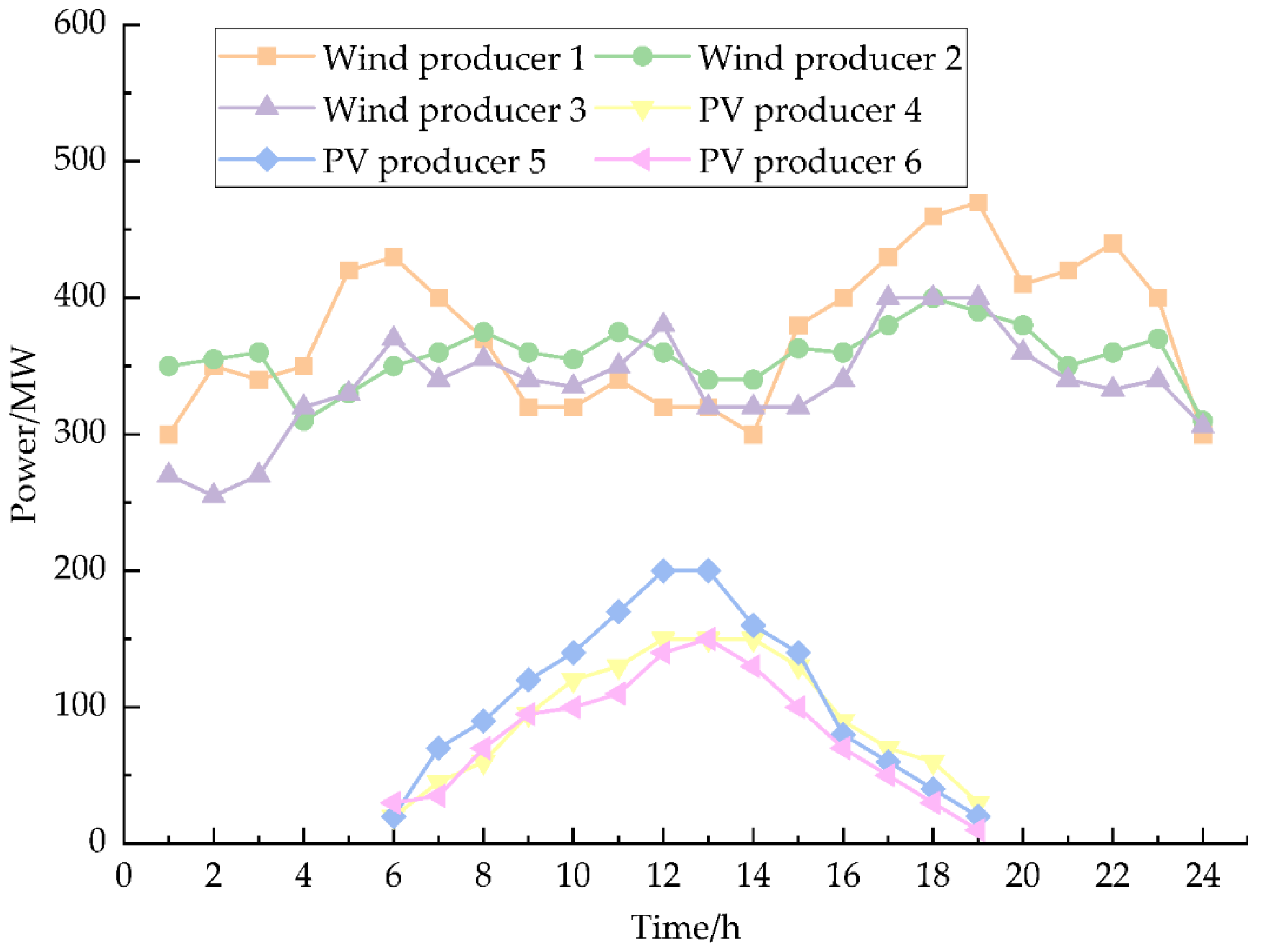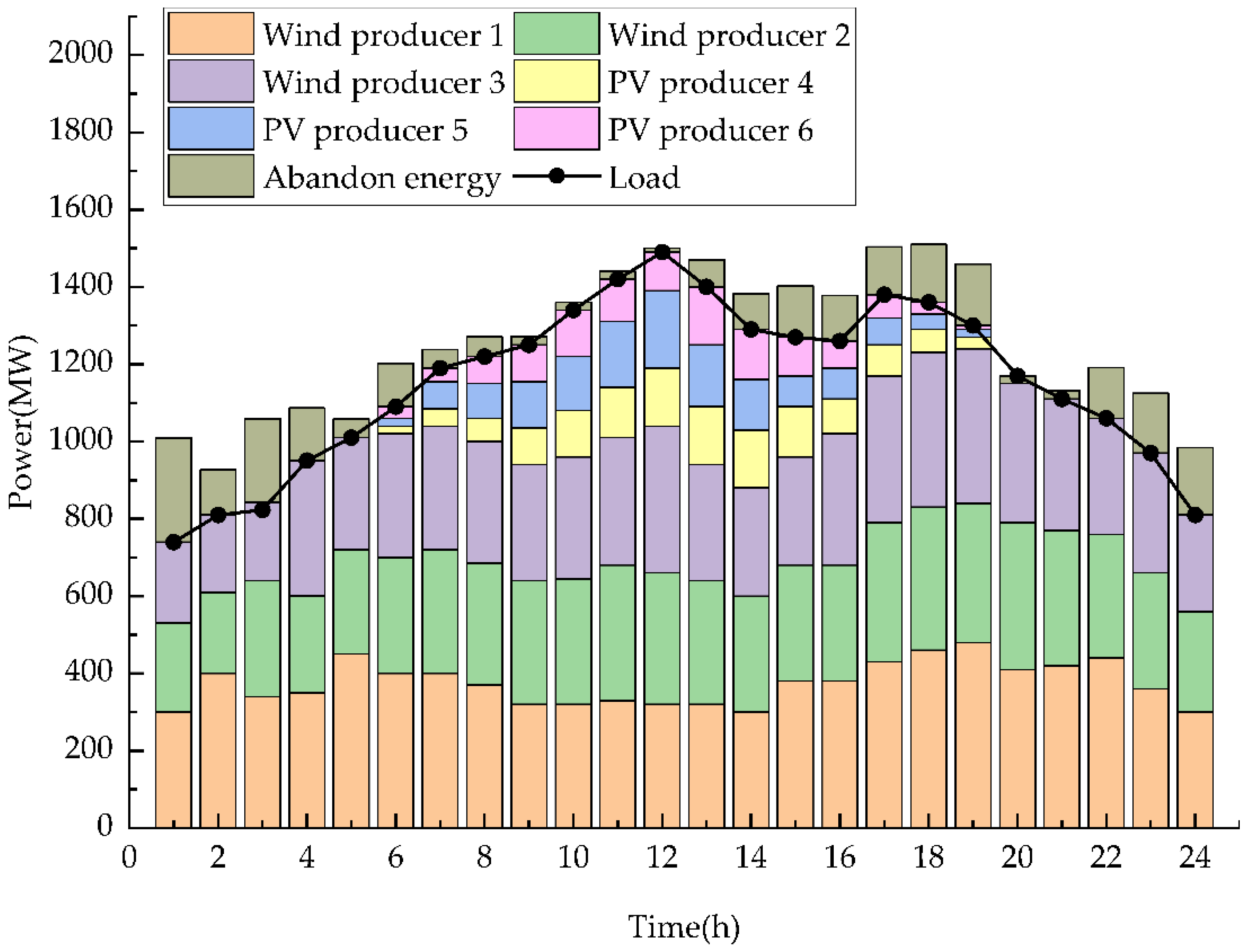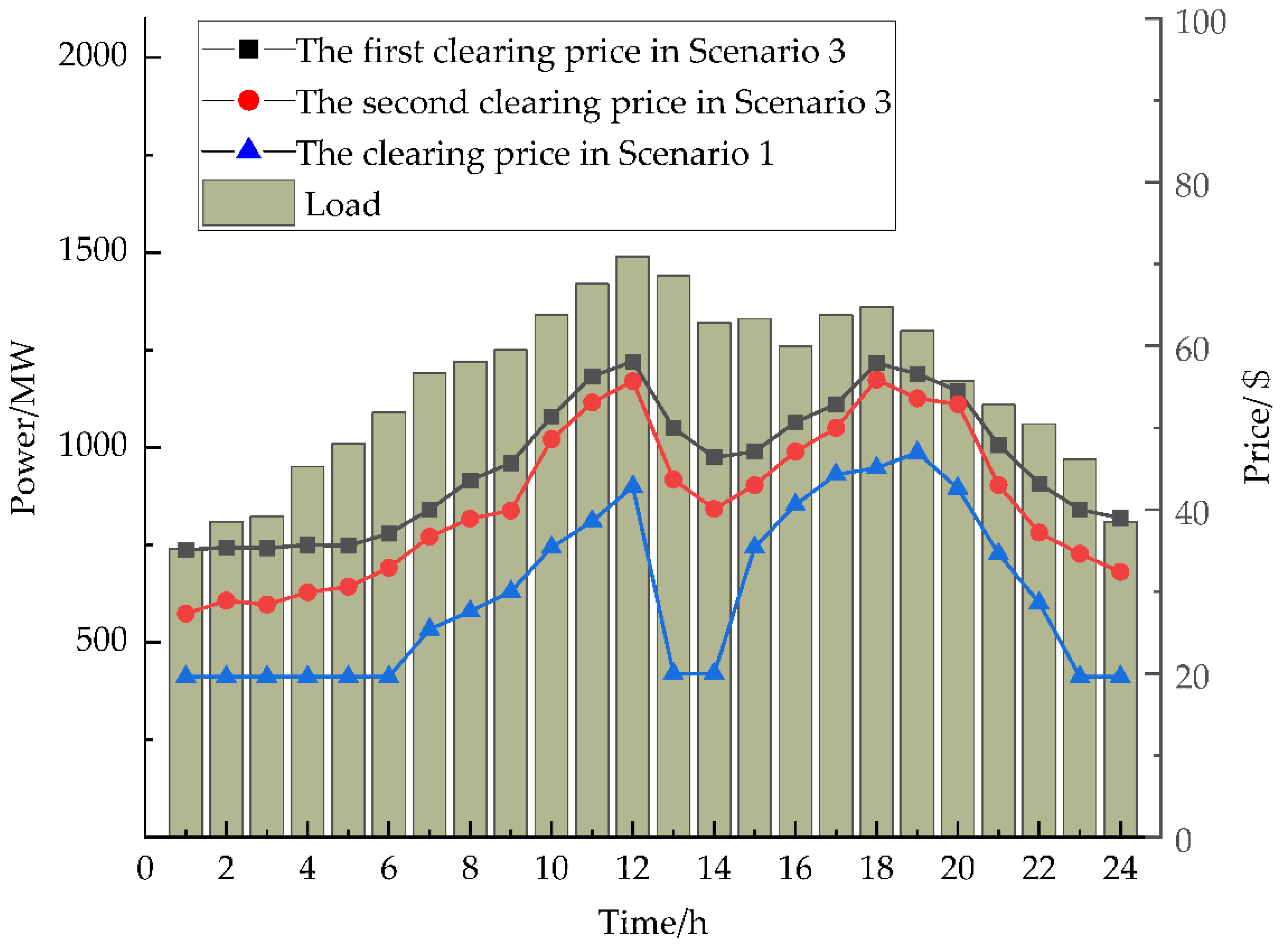Research on the Electricity Market Clearing Model for Renewable Energy
Abstract
:1. Introduction
2. Design of Electricity Market Mechanism for Renewable Energy
3. Renewable Energy Power Generation Negotiation Volume and Price Declaration Strategy
3.1. A Quotation Model Considering Renewable Energy Generation Costs and Rival Strategies
- Step 1: Set to generate a lower triangular matrix such that .
- Step 2: Generate mutually independent two-dimensional standard normal distribution random vectors , , where , .
- Step 3:.
3.2. Expectation Model of Renewable Energy Producers
4. Renewable Energy Power Market Clearing Model Based on Two-Stage Centralized Bidding
4.1. The First Clearing Model of the Renewable Energy Power Market
- (1)
- System Power Balancing Constraints
- (2)
- System Reserve Capacity Constraints with Renewable Energy Participation
- (3)
- Unit Operating Constraints
- (4)
- Transmission Capacity Constraints of Each Line
4.2. The Second Stage Clearing Model of the Renewable Energy Power Market
4.3. Model Solving Process
5. Case Analysis
5.1. Parameter Settings
5.2. Electricity Market Clearing Results
5.3. Electricity Market Clears Electricity Price and Income
6. Conclusions
- (1)
- The quotation model of renewable energy producers proposed in this paper comprehensively considers the power generation cost, backup cost and the uncertainty of competitors’ quotations of renewable energy producers. To a certain extent, irrational quotations by producers are prevented, so that renewable energy producers can obtain maximum benefits.
- (2)
- The renewable energy power market transaction mechanism proposed in this paper increases the market participation of renewable energy producers and users. Make more renewable energy producers participate in transactions through the market. As a supplement to the first-stage clearing, the second-stage clearing price is reduced by 8.8% on average compared with the first-stage clearing price, which reduces the cost of electricity purchase to a certain extent and encourages users to purchase renewable energy electricity.
- (3)
- The two-stage centralized bidding power market clearing model proposed in this paper can reduce the total energy waste in the power system through a market-oriented mechanism to a certain extent. The rate of energy waste dropped from 8.7% to 2.1%, and the profit margin of renewable energy producers increased by 6.7%, promoting the consumption of renewable energy.
- (1)
- Regarding the design of the renewable energy power market mechanism, this paper does not consider the impact of relevant laws and regulations and the construction of the renewable energy power market mechanism. In future research, we can explore the impact of relevant laws and regulations on the construction of the power market mechanism.
- (2)
- Due to the large-scale integration of renewable energy into the grid, the volatility and uncertainty of the output on the power generation side increase. In future research, we will explore the establishment of a deviation power assessment mechanism that adapts to the characteristics of renewable energy power generation.
Author Contributions
Funding
Data Availability Statement
Conflicts of Interest
Appendix A
| New Energy Producer | ||
|---|---|---|
| Wind producer 1 | 0.9 | 0.32 |
| Wind producer 2 | 1.3 | 0.36 |
| Wind producer 3 | 1.1 | 0.33 |
| PV producer 4 | 0.7 | 0.22 |
| PV producer 5 | 0.9 | 0.30 |
| PV producer 6 | 0.8 | 0.28 |
| Time | /($/(MW·h) | /($/(MW·h) | Time | /($/(MW·h) | /($/(MW·h) |
|---|---|---|---|---|---|
| 1 | 0.99 | 0.36 | 13 | 1.29 | 0.29 |
| 2 | 1.10 | 0.35 | 14 | 1.30 | 0.32 |
| 3 | 0.99 | 0.37 | 15 | 1.31 | 0.32 |
| 4 | 0.98 | 0.38 | 16 | 1.35 | 0.34 |
| 5 | 1.13 | 0.30 | 17 | 1.56 | 0.29 |
| 6 | 1.20 | 0.24 | 18 | 1.57 | 0.29 |
| 7 | 1.54 | 0.27 | 19 | 1.59 | 0.28 |
| 8 | 1.54 | 0.25 | 20 | 1.59 | 0.28 |
| 9 | 1.56 | 0.29 | 21 | 1.55 | 0.29 |
| 10 | 1.57 | 0.29 | 22 | 1.59 | 0.29 |
| 11 | 1.60 | 0.27 | 23 | 1.40 | 0.30 |
| 12 | 1.60 | 0.27 | 24 | 1.20 | 0.32 |
| Time | /($/(MW·h) | /($/(MW·h) | Time | /($/(MW·h) | /($/(MW·h) |
|---|---|---|---|---|---|
| 1 | 0.98 | 0.36 | 13 | 1.34 | 0.27 |
| 2 | 0.99 | 0.34 | 14 | 1.27 | 0.27 |
| 3 | 0.93 | 0.35 | 15 | 1.26 | 0.26 |
| 4 | 0.94 | 0.34 | 16 | 1.34 | 0.26 |
| 5 | 1.12 | 0.23 | 17 | 1.56 | 0.27 |
| 6 | 1.17 | 0.24 | 18 | 1.57 | 0.27 |
| 7 | 1.48 | 0.24 | 19 | 1.57 | 0.27 |
| 8 | 1.56 | 0.24 | 20 | 1.56 | 0.25 |
| 9 | 1.56 | 0.26 | 21 | 1.58 | 0.25 |
| 10 | 1.56 | 0.26 | 22 | 1.58 | 0.26 |
| 11 | 1.58 | 0.25 | 23 | 1.52 | 0.26 |
| 12 | 1.58 | 0.26 | 24 | 1.15 | 0.23 |
| Time | /($/(MW·h) | /($/(MW·h) | Time | /($/(MW·h) | /($/(MW·h) |
|---|---|---|---|---|---|
| 7 | 1.28 | 0.18 | 14 | 1.07 | 0.23 |
| 8 | 1.36 | 0.19 | 15 | 1.06 | 0.21 |
| 9 | 1.36 | 0.21 | 16 | 1.14 | 0.21 |
| 10 | 1.36 | 0.21 | 17 | 1.36 | 0.23 |
| 11 | 1.38 | 0.21 | 18 | 1.37 | 0.22 |
| 12 | 1.38 | 0.19 | 19 | 1.37 | 0.22 |
| 13 | 1.14 | 0.21 |
| Time | /($/(MW·h) | /($/(MW·h) | Time | /($/(MW·h) | /($/(MW·h) |
|---|---|---|---|---|---|
| 7 | 1.30 | 0.20 | 14 | 1.17 | 0.24 |
| 8 | 1.38 | 0.21 | 15 | 1.16 | 0.22 |
| 9 | 1.38 | 0.22 | 16 | 1.17 | 0.22 |
| 10 | 1.38 | 0.23 | 17 | 1.40 | 0.22 |
| 11 | 1.38 | 0.23 | 18 | 1.40 | 0.24 |
| 12 | 1.40 | 0.21 | 19 | 1.40 | 0.24 |
| 13 | 1.24 | 0.23 |
| Time | /($/(MW·h) | /($/(MW·h) | Time | /($/(MW·h) | /($/(MW·h) |
|---|---|---|---|---|---|
| 7 | 1.29 | 0.19 | 14 | 1.05 | 0.20 |
| 8 | 1.37 | 0.17 | 15 | 1.06 | 0.21 |
| 9 | 1.36 | 0.20 | 16 | 1.46 | 0.23 |
| 10 | 1.37 | 0.21 | 17 | 1.36 | 0.23 |
| 11 | 1.37 | 0.21 | 18 | 1.37 | 0.24 |
| 12 | 1.38 | 0.22 | 19 | 1.36 | 0.20 |
| 13 | 1.15 | 0.21 |
References
- Qiu, S.; Lei, T.; Wu, J.; Bi, S. Energy demand and supply planning of China through 2060. Energy 2021, 234, 121–193. [Google Scholar] [CrossRef]
- Li, B.; Chen, M.; Zhong, H.; Ma, Z.; Liu, D.; He, G. A Review of Long-Term Planning of New Power Systems with Large Share of Renewable Energy. Proc. CSEE 2022, 1, 1–27. [Google Scholar]
- Lbrahim, R.I.; Ozturk, I.; Bello, A.K.; Raimi, L. On the criticality of renewable energy to sustainable development: Do green financial development, technological innovation, and economic complexity matter for China? Renew. Energy 2022, 199, 262–277. [Google Scholar] [CrossRef]
- Hansen, K.; Breyer, C.; Lund, H. Status and perspectives on 100% renewable energy systems. Energy 2019, 175, 471–480. [Google Scholar] [CrossRef]
- Abhyankar, N.; Lin, J.; Kahrl, F.; Yin, S.; Paliwal, U.; Liu, X. Achieving an 80% carbon-free electricity system in China by 2035. iScience 2022, 25, 105–120. [Google Scholar] [CrossRef]
- Buchholz, W.; Dippl, L.; Eichenseer, M. Subsidizing renewables as part of taking leadership in international climate policy. Energy Policy 2019, 129, 765–773. [Google Scholar] [CrossRef]
- Wang, Y.; Shi, R.; Zhang, C.; He, Y.; Jiang, H.; Kubota, J. Structural changes and trends in China’s renewable electricity production in the policy evolution process. Renew. Energy 2022, 182, 879–886. [Google Scholar] [CrossRef]
- Xu, R.; Song, Z.; Tang, Q.; Yu, Z. The cost and marketability of renewable energy after power market reform in China: A review. Clean. Prod. 2018, 204, 409–424. [Google Scholar]
- Koolen, D.; Huisman, R.; Ketter, W. Decision strategies in sequential power markets with renewable energy. Energy Policy 2022, 167, 113025. [Google Scholar] [CrossRef]
- Gountis, V.; Bakirtzis, A. Bidding strategies for electricity producers in a competitive electricity marketplace. IEEE Trans. Power Syst. 2004, 19, 356–365. [Google Scholar] [CrossRef]
- Mehdipourpicha, H.; Wang, S.; Bo, R. Developing Robust Bidding Strategy for Virtual Bidders in Day-Ahead Electricity Markets. IEEE Open Access Power Energy 2021, 8, 329–340. [Google Scholar] [CrossRef]
- Rampriya, B. Optimal Bidding and Generation Scheduling of Utilities Participating in Single Side Auction Markets Including Ancillary Services. Adv. Appl. Sci. 2018, 7, 46–53. [Google Scholar] [CrossRef]
- Nogales, F.; Contreras, J.; Conejo, A.; Espinola, R. Forecasting Next-Day Electricity Prices by Time Series Models. IEEE Power Eng. Rev. 2002, 3, 22. [Google Scholar]
- Zhou, T.; Chi, D.; Ai, M. Challenges and countermeasures for renewable energy in the context of dual carbon. Macroecon. Manag. 2022, 7, 59–65. [Google Scholar]
- Wang, Q.; Du, Q.; Dai, X. Renewable Energy Development toward Carbon Neutrality: A Research Review. J. Nanjing Univ. Aeronaut. Astronaut. 2022, 4, 79–89. [Google Scholar]
- Zhang, Q.; Huang, X.; Xu, Y. New energy demonstration city pilot and green energy consumption: Evidences from China. Energy Rep. 2022, 8, 7735–7750. [Google Scholar] [CrossRef]
- Zhou, Q.; Wang, N.; He, S.; Shen, C. Summary and prospect of China’s new energy development under the background of high abandoned new energy power. Power Syst. Prot. Control 2017, 45, 146–154. [Google Scholar]
- Liu, P.; Hei, Z. Strategic analysis and framework design on international cooperation for energy transition: A perspective from China. Energy Rep. 2022, 8, 2601–2616. [Google Scholar] [CrossRef]
- Çiçek, A.; Güzel, S.; Erdinç, O.; Catalão, J. Comprehensive survey on support policies and optimal market participation of renewable energy. Electr. Power Syst. Res. 2021, 201, 107522. [Google Scholar] [CrossRef]
- Fan, Y.; Ding, T.; He, Y.; Wang, C.; Wang, Y.; Cheng, T.; Liu, J. Review and Cogitation for Worldwide Spot Market Development to Promote Renewable Energy Accommodation. Proc. CSEE 2021, 41, 1729–1752. [Google Scholar]
- Wang, C.; Lei, X.; Liu, L.; Li, Z. Design of Short-term Renewable Energy Integration Mechanism in the Electricity Market Transition Period. J. Glob. Energy Interconnect. 2018, 1, 565–573. [Google Scholar]
- Zeng, D.; Xie, K.; Pang, B.; Li, Z.; Yang, Z. Key Issues of National Unified Electricity Market with Chinese Characteristics (3): Transaction Clearing Models and Algorithms Adapting to the Coordinated Operation of Provincial Electricity Markets. Power Syst. Technol. 2020, 44, 2809–2819. [Google Scholar]
- Abate, A.G.; Riccardi, R.; Ruiz, C. Contract design in electricity markets with high penetration of renewables: A two-stage approach. Omega 2022, 111, 102666. [Google Scholar] [CrossRef]
- Simon, S.H.; Leach, A.; Shaffer, B.; Weis, T. Alberta’s Renewable Electricity Program: Design, results, and lessons learned. Energy Policy 2022, 171, 113266. [Google Scholar] [CrossRef]
- Newbery, D.; Pollitt, M.G.; Ritz, R.A.; Strielkowski, W. Market design for a high-renewables European electricity system. Renew. Sustain. Energy Rev. 2018, 91, 695–707. [Google Scholar] [CrossRef] [Green Version]
- Kang, C.; Du, E.; Zhang, N.; Chen, Q.; Huang, H.; Wu, S. Renewable Energy Trading in Electricity Market: Review and Prospect. South. Power Syst. Technol. 2016, 10, 16–23. [Google Scholar]
- Cheng, G.; Liang, Z.; Dong, Y. Analysis and Reflection on the Marketization Construction of Electric Power with Chinese Characteristics Based on Energy Transformation. Proc. CSEE 2020, 40, 369–379. [Google Scholar]
- Yang, J.; Liu, C.; Mi, Y.; Zhang, H.; Terzija, V. Optimization operation model of electricity market considering renewable energy accommodation and flexibility requirement. Glob. Energy Interconnect. 2021, 4, 227–238. [Google Scholar] [CrossRef]
- Cai, T.; Dong, M.; Chen, K.; Gong, T. Methods of participating power spot market bidding and settlement for renewable energy systems. Energy Rep. 2022, 8, 7764–7772. [Google Scholar] [CrossRef]
- Chen, H.; Gao, X.; Liu, J.; Zhang, Q.; Yu, S.; Kang, J.; Yan, R.; Wei, Y. The grid parity analysis of onshore wind power in China: A system cost perspective. Renew. Energy 2020, 148, 22–30. [Google Scholar] [CrossRef]
- Ouyang, X.; Lin, B. Levelized cost of electricity (LCOE) of renewable energies and required subsidies in China. Energy Policy 2014, 70, 64–73. [Google Scholar] [CrossRef]
- Namalomba, E.; Hu, F.; Shi, H. Agent based simulation of centralized electricity transaction market using bi-level and Q-learning algorithm approach. Electr. Power Energy Syst. 2022, 134, 32–41. [Google Scholar] [CrossRef]
- Mitridati, L.; Pinson, P. A Bayesian Inference Approach to Unveil Supply Curves in Electricity Markets. IEEE Trans. Power Syst. 2018, 33, 2610–2620. [Google Scholar] [CrossRef] [Green Version]
- Chen, Q.; Liu, X.; Fang, X.; Guo, H.; Lin, Q. Electricity Market Clearing Mechanism Considering Guaranteed Accommodation of Renewable Energy. Autom. Electr. Power Syst. 2021, 45, 26–33. [Google Scholar]
- Wen, F.; David, A. Optimal bidding strategies for competitive generators and large consumers. Electr. Power Energy Syst. 2001, 23, 37–43. [Google Scholar] [CrossRef]
- Wang, B.; Guo, C.; Zhang, W.; Wu, X. Participation Patterns of Renewable Energy in Spot Electricity Market and Its Impact on Market Clearing Price. Smart Power 2021, 49, 56–63. [Google Scholar] [CrossRef]







| New Energy Producer | ($/(MW·h) | ($/(MW·h) | Installed Capacity/MW |
|---|---|---|---|
| Wind producer 1 | 36.2 | 0.32 | 500 |
| Wind producer 2 | 37.2 | 0.36 | 400 |
| Wind producer 3 | 39.0 | 0.53 | 400 |
| PV producer 4 | 35.5 | 0.32 | 200 |
| PV producer 5 | 36.2 | 0.3 | 200 |
| PV producer 6 | 34.2 | 0.28 | 200 |
| Time | /($/(MW·h) | /($/(MW·h) | Time | /($/(MW·h) | /($/(MW·h) |
|---|---|---|---|---|---|
| 1 | 0.96 | 0.32 | 13 | 1.29 | 0.24 |
| 2 | 0.93 | 0.31 | 14 | 1.25 | 0.23 |
| 3 | 0.89 | 0.33 | 15 | 1.21 | 0.24 |
| 4 | 0.82 | 0.31 | 16 | 1.30 | 0.24 |
| 5 | 1.02 | 0.23 | 17 | 1.51 | 0.24 |
| 6 | 1.13 | 0.24 | 18 | 1.53 | 0.23 |
| 7 | 1.45 | 0.23 | 19 | 1.54 | 0.24 |
| 8 | 1.53 | 0.21 | 20 | 1.52 | 0.23 |
| 9 | 1.54 | 0.24 | 21 | 1.53 | 0.24 |
| 10 | 1.56 | 0.24 | 22 | 1.56 | 0.24 |
| 11 | 1.55 | 0.24 | 23 | 1.36 | 0.24 |
| 12 | 1.58 | 0.23 | 24 | 0.88 | 0.31 |
| Scenario | Abandoned Wind Power/ (MW·h) | Abandoned PV Power/ (MW·h) |
|---|---|---|
| 1 | 459 | 0 |
| 2 | 2288 | 130 |
| 3 | 559 | 0 |
| New Energy Producer | Increased Output | Average Clearing Price/$ | Revenue |
|---|---|---|---|
| Wind producer 1 | 210 | 43.8 | 9198 |
| Wind producer 2 | 1053 | 41.1 | 43,278 |
| Wind producer 3 | 448 | 36.6 | 16,396 |
| PV producer 5 | 130 | 36.7 | 6071 |
Publisher’s Note: MDPI stays neutral with regard to jurisdictional claims in published maps and institutional affiliations. |
© 2022 by the authors. Licensee MDPI, Basel, Switzerland. This article is an open access article distributed under the terms and conditions of the Creative Commons Attribution (CC BY) license (https://creativecommons.org/licenses/by/4.0/).
Share and Cite
Xu, G.; Wang, X. Research on the Electricity Market Clearing Model for Renewable Energy. Energies 2022, 15, 9124. https://doi.org/10.3390/en15239124
Xu G, Wang X. Research on the Electricity Market Clearing Model for Renewable Energy. Energies. 2022; 15(23):9124. https://doi.org/10.3390/en15239124
Chicago/Turabian StyleXu, Gaoyuan, and Xiaojing Wang. 2022. "Research on the Electricity Market Clearing Model for Renewable Energy" Energies 15, no. 23: 9124. https://doi.org/10.3390/en15239124







